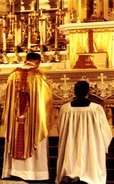[Taken from Rorate Caeli]
The Tridentine Mass is completely celebrated in Latin, with the exception of a few words and sentences in Ancient Greek and in Hebrew; it is interspersed with long periods of silence, to allow the faithful to adequately meditate on the greatness of the Eucharistic mystery which they are called to attend. The faithful follow the liturgy reading the bilingual handmissal or leaflet, which carry, side by side with the Latin text, the integral translation of the actions in Italian or in the other national languages.
It is not only the use of the ecclesiastical and universal language ("Catholic" means precisely universal) which represents the sole standing difference between the Tridentine Mass and the modern one. The priest, differently than what takes place in the course of the new rite, turns his back to the faithful, as he celebrates turned to the tabernacle and the altar which constitutes the representation of Calvary; the image is that of the celebrant who guides the people.
The Gospel is always read at the right side of the altar, while the Epistle on the left side (from whence the terms "in cornu evangelii" and "in cornu epistulae"). Communion - only the Host [sic] for the faithful - is received while kneeling and in the mouth. [Psalmus 42 Comment: The Tridentine Mass has specific rubrics to signify the life of Christ on earth. The center of the altar represents Jerusalem, where Christ was sacrificed. The priest, facing east, ascends to the center of the altar and kisses it. He then moves to the south to read the introit, which is the first prayer that changes in the Mass. He moves south because Bethlehem, where Christ was born, is south of Jerusalem. The priest faces east when he reads the prayer. The reason the priest moves south for the first changeable prayer is because it signifies the beginning of the Mass of the day. It is a the "birth" of a new Mass, just as Christ was born in Bethlehem.
The priest returns to the center for the Kyrie and Gloria. Christ gave glory to the Father and poured out his mercy for us in Jerusalem, which is why the priest returns to the center.
The priest the reads the collect and epistle at the south end of the altar, again to signify the birth of Christ. The collect is just as it sounds, the priest offering the prayer for the people to the Father. The epistle is a reading from the Old or New Testament which compliments the Gospel reading of the day.
When the priest finishes the epistle, he returns to the center to say the munda cor, which he asks God to "purify his lips to proclaim the Gospel." This corresponds again to Christ's sacrifice on the cross in Jerusalem to purify us from our sins.
The priest then moves north to proclaim the Gospel. The reason for this is because Nazareth, where Jesus lived for the first 30 years of His life, is north of Jerusalem. Jesus began his mission to preach the Gospel from Nazareth, which is why the priest reads the Gospel at the north end of the altar. (Reference)]
[The faithful] mostly kneel during Mass, because [they] believe in its great mystery, because [they] believe in the real presence of Jesus in body, blood, soul, and divinity, because kneeling is the posture of the humble sinner who begs for God's mercy.
Subscribe to:
Post Comments (Atom)



No comments:
Post a Comment